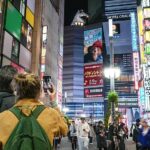Inbound tourism refers to the activity of travelers entering a country other than their own for leisure, business, or other purposes, and SIXT.VN understands the nuances of this crucial aspect of the tourism industry in Vietnam. We provide streamlined travel solutions tailored for international visitors, ensuring they experience the best of Vietnamese hospitality and attractions. Let us help you navigate international tourism, explore tourist arrivals, and unlock unique travel experiences.
Contents
- 1. Understanding Inbound Tourism
- 1.1. What is Inbound Tourism?
- 1.2. How Does Inbound Tourism Differ from Outbound and Domestic Tourism?
- 1.3. What are the Key Components of Inbound Tourism?
- 2. The Importance of Inbound Tourism for Vietnam
- 2.1. Economic Benefits of Inbound Tourism
- 2.2. How Inbound Tourism Creates Jobs in Vietnam
- 2.3. The Role of Inbound Tourism in Infrastructure Development
- 3. Factors Influencing Inbound Tourism to Vietnam
- 3.1. Political and Economic Stability
- 3.2. Marketing and Promotion of Vietnam as a Destination
- 3.3. Visa Policies and Accessibility
- 3.4. Exchange Rates and Affordability
- 3.5. Global Events and Trends
- 4. Challenges and Opportunities in Vietnam’s Inbound Tourism
- 4.1. Infrastructure Limitations
- 4.2. Environmental Concerns and Sustainability
- 4.3. Cultural Preservation and Authenticity
- 4.4. Competition from Other Destinations
- 4.5. Opportunities for Growth and Innovation
- 5. Impact of COVID-19 on Inbound Tourism and Recovery Strategies
- 5.1. Immediate Impact of the Pandemic
- 5.2. Government Measures and Support for the Tourism Industry
- 5.3. Adapting to the New Normal: Health and Safety Measures
- 5.4. Promoting Domestic Tourism to Offset Losses
- 5.5. Future Strategies for Rebuilding Inbound Tourism
- 6. Key Regions for Inbound Tourism in Vietnam
- 6.1. Hanoi: The Cultural Capital
- 6.2. Ho Chi Minh City: The Economic Hub
- 6.3. Ha Long Bay: The Natural Wonder
- 6.4. Da Nang: The Coastal City
- 6.5. Hoi An: The Ancient Town
- 7. Trends Shaping Inbound Tourism in Vietnam
- 7.1. Sustainable Tourism
- 7.2. Experiential Travel
- 7.3. Digital Nomadism
- 7.4. Wellness Tourism
- 7.5. Solo Travel
- 8. SIXT.VN’s Role in Facilitating Inbound Tourism to Vietnam
- 8.1. Services Offered by SIXT.VN
- 8.2. Airport Transfer Services
- 8.3. Hotel Booking Assistance
- 8.4. Customizable Tour Packages
- 8.5. Car Rental Options for Independent Exploration
- 8.6. How SIXT.VN Enhances the Tourist Experience
- 9. Planning Your Inbound Trip to Vietnam: A Step-by-Step Guide
- 9.1. Visa Requirements and Entry Regulations
- 9.2. Best Time to Visit Vietnam
- 9.3. What to Pack for Your Trip
- 9.4. Currency and Payment Options
- 9.5. Local Customs and Etiquette
- 9.6. Essential Vietnamese Phrases
- 10. Maximizing the Benefits of Inbound Tourism in Vietnam
- 10.1. Supporting Local Businesses and Communities
- 10.2. Practicing Responsible Tourism
- 10.3. Engaging with Local Culture
- 10.4. Leaving a Positive Impact
- 10.5. Continuous Improvement and Adaptation
- 11. The Future of Inbound Tourism in Vietnam
- 11.1. Long-Term Growth Prospects
- 11.2. Emerging Markets and Opportunities
- 11.3. Technology and Innovation in Tourism
- 11.4. Sustainability and Resilience
- 11.5. Collaboration and Partnerships
- 12. Case Studies: Successful Inbound Tourism Strategies
- 12.1. Thailand’s Medical Tourism
- 12.2. Costa Rica’s Eco-Tourism
- 12.3. Iceland’s Adventure Tourism
- 12.4. Singapore’s MICE Tourism
- 12.5. Dubai’s Luxury Tourism
- 13. FAQ: Your Questions About Inbound Tourism Answered
- 13.1. What is the difference between inbound and outbound tourism?
- 13.2. Why is inbound tourism important for a country’s economy?
- 13.3. What are some of the challenges facing inbound tourism in Vietnam?
- 13.4. How can Vietnam promote sustainable tourism?
- 13.5. What role does technology play in inbound tourism?
- 13.6. What are some popular destinations for inbound tourists in Vietnam?
- 13.7. How can SIXT.VN help with my inbound trip to Vietnam?
- 13.8. What is the best time to visit Vietnam?
- 13.9. What should I pack for my trip to Vietnam?
- 13.10. How can I support local businesses and communities during my trip?
- 14. Conclusion: Embracing the Opportunities of Inbound Tourism in Vietnam
1. Understanding Inbound Tourism
1.1. What is Inbound Tourism?
Inbound tourism is when individuals travel to a country that is not their country of residence for tourism purposes. It’s a vital component of the global tourism industry, significantly contributing to the economy of the destination country. According to the United Nations World Tourism Organization (UNWTO), international tourist arrivals reached 1.5 billion in 2019, showcasing the vast scale of inbound tourism globally.
1.2. How Does Inbound Tourism Differ from Outbound and Domestic Tourism?
Inbound tourism involves visitors from abroad entering a country. Outbound tourism involves residents of a country traveling to another country. Domestic tourism involves residents of a country traveling within their own country. The key differentiator is the crossing of international borders.
| Type of Tourism | Definition | Example |
|---|---|---|
| Inbound | Non-residents traveling to a country. | A tourist from the USA visiting Vietnam. |
| Outbound | Residents traveling to another country. | A Vietnamese citizen traveling to Japan for vacation. |
| Domestic | Residents traveling within their own country. | A Vietnamese citizen traveling from Hanoi to Ho Chi Minh City. |
1.3. What are the Key Components of Inbound Tourism?
Key components include transportation, accommodation, attractions, activities, and services catering to international visitors. These components must be aligned to provide a seamless experience for tourists.
- Transportation: Flights, trains, buses, and local transport services like taxis and ride-sharing.
- Accommodation: Hotels, resorts, hostels, and vacation rentals.
- Attractions: Cultural sites, natural landmarks, theme parks, and museums.
- Activities: Tours, excursions, adventure sports, and local experiences.
- Services: Travel agencies, tour guides, currency exchange, and language assistance.
2. The Importance of Inbound Tourism for Vietnam
2.1. Economic Benefits of Inbound Tourism
Inbound tourism significantly boosts Vietnam’s economy by generating foreign exchange, increasing employment, and supporting local businesses. According to the Vietnam National Administration of Tourism (VNAT), tourism contributed approximately 9.2% to Vietnam’s GDP in 2019. This underlines the crucial role inbound tourism plays in the country’s economic health.
2.2. How Inbound Tourism Creates Jobs in Vietnam
The tourism sector in Vietnam employs millions, directly and indirectly. Hotels, restaurants, tour operators, and transportation services all require a substantial workforce. According to the General Statistics Office of Vietnam, the tourism sector employed over 6.5 million people in 2019, highlighting its significance as a source of employment.
2.3. The Role of Inbound Tourism in Infrastructure Development
Increased tourism drives investment in infrastructure, including airports, roads, and tourist facilities, enhancing overall development. Investment in infrastructure is crucial for sustaining and growing tourism, ensuring that Vietnam remains an attractive destination.
3. Factors Influencing Inbound Tourism to Vietnam
3.1. Political and Economic Stability
A stable political and economic environment is crucial for attracting tourists. Vietnam’s relative stability has been a key factor in its growing tourism industry.
3.2. Marketing and Promotion of Vietnam as a Destination
Effective marketing campaigns showcase Vietnam’s attractions and cultural richness, drawing in more tourists. VNAT actively promotes Vietnam through international tourism fairs, digital marketing, and collaborations with international media.
3.3. Visa Policies and Accessibility
Liberal visa policies and improved air connectivity make it easier for tourists to visit Vietnam. The Vietnamese government has been gradually easing visa requirements for several countries to boost tourism.
3.4. Exchange Rates and Affordability
Favorable exchange rates make Vietnam an attractive and affordable destination for many tourists. The cost of travel, accommodation, and services in Vietnam is often lower compared to other popular destinations, making it an appealing choice.
3.5. Global Events and Trends
Global events, such as the COVID-19 pandemic, and tourism trends significantly impact inbound tourism. Adapting to new trends and ensuring health and safety are essential for recovery and growth.
4. Challenges and Opportunities in Vietnam’s Inbound Tourism
4.1. Infrastructure Limitations
While Vietnam has made strides in infrastructure development, limitations remain, particularly in remote areas. Upgrading infrastructure is essential to accommodate growing tourist numbers and improve the overall experience.
4.2. Environmental Concerns and Sustainability
Balancing tourism growth with environmental protection is a key challenge. Sustainable tourism practices are crucial to preserving Vietnam’s natural beauty.
4.3. Cultural Preservation and Authenticity
Maintaining cultural authenticity while catering to tourist demands is essential. Promoting responsible tourism that respects local traditions and customs is vital.
4.4. Competition from Other Destinations
Vietnam faces competition from other Southeast Asian countries and beyond. Differentiating itself through unique experiences and high-quality services is essential.
4.5. Opportunities for Growth and Innovation
Opportunities exist in niche tourism markets, such as eco-tourism, adventure tourism, and cultural tourism. Innovation in tourism products and services can attract new segments of tourists.
5. Impact of COVID-19 on Inbound Tourism and Recovery Strategies
5.1. Immediate Impact of the Pandemic
The COVID-19 pandemic caused a drastic decline in inbound tourism due to travel restrictions and health concerns. According to VNAT, international tourist arrivals plummeted by over 70% in 2020.
5.2. Government Measures and Support for the Tourism Industry
The Vietnamese government implemented various measures to support the tourism industry, including financial aid, tax breaks, and promotional campaigns. These measures aimed to help businesses survive the crisis and prepare for recovery.
5.3. Adapting to the New Normal: Health and Safety Measures
Implementing strict health and safety protocols is crucial for restoring tourist confidence. This includes enhanced hygiene standards, social distancing measures, and health screenings.
5.4. Promoting Domestic Tourism to Offset Losses
Encouraging domestic tourism can help offset some of the losses from the decline in international arrivals. Promotional campaigns and incentives can stimulate local travel.
5.5. Future Strategies for Rebuilding Inbound Tourism
Future strategies include targeted marketing campaigns, easing travel restrictions, and developing new tourism products that cater to changing preferences. Collaboration between government, industry, and local communities is essential for successful recovery.
6. Key Regions for Inbound Tourism in Vietnam
6.1. Hanoi: The Cultural Capital
Hanoi attracts tourists with its rich history, ancient temples, and vibrant street life. Key attractions include Hoan Kiem Lake, the Old Quarter, and the Temple of Literature.
6.2. Ho Chi Minh City: The Economic Hub
Ho Chi Minh City offers a mix of modern skyscrapers and historic landmarks, attracting business and leisure travelers. Key attractions include the War Remnants Museum, Notre-Dame Cathedral, and the Cu Chi Tunnels.
6.3. Ha Long Bay: The Natural Wonder
Ha Long Bay is famous for its stunning limestone karsts and emerald waters, making it a must-visit destination. Cruises and kayaking tours are popular activities.
6.4. Da Nang: The Coastal City
Da Nang boasts beautiful beaches, modern infrastructure, and cultural attractions. Key attractions include My Khe Beach, the Marble Mountains, and the Dragon Bridge.
6.5. Hoi An: The Ancient Town
Hoi An is a UNESCO World Heritage Site known for its well-preserved ancient architecture and tailor shops. Key attractions include the Japanese Covered Bridge, the Old Town, and the nearby beaches.
7. Trends Shaping Inbound Tourism in Vietnam
7.1. Sustainable Tourism
A growing emphasis on eco-friendly and responsible travel. Tourists are increasingly seeking accommodations and tours that minimize environmental impact and support local communities.
7.2. Experiential Travel
Travelers are looking for authentic experiences that immerse them in local culture. This includes cooking classes, homestays, and participation in traditional festivals.
7.3. Digital Nomadism
Vietnam is becoming an attractive destination for digital nomads due to its affordability and internet connectivity. Co-working spaces and long-stay accommodations are catering to this market.
7.4. Wellness Tourism
A focus on health and wellness, with tourists seeking spa treatments, yoga retreats, and healthy cuisine. Vietnam’s natural beauty and traditional healing practices make it an appealing destination.
7.5. Solo Travel
An increasing number of people are traveling alone, seeking adventure and self-discovery. Vietnam’s safety and ease of travel make it a popular choice for solo travelers.
8. SIXT.VN’s Role in Facilitating Inbound Tourism to Vietnam
8.1. Services Offered by SIXT.VN
SIXT.VN provides a range of services tailored for inbound tourists, including airport transfers, hotel bookings, tour packages, and car rentals. We aim to make travel seamless and convenient.
8.2. Airport Transfer Services
Reliable and comfortable airport transfers ensure a smooth start to any trip. SIXT.VN offers a variety of vehicles to suit different needs and budgets.
8.3. Hotel Booking Assistance
Assistance in finding the perfect accommodation, from budget-friendly hostels to luxury hotels. SIXT.VN partners with a wide range of hotels to offer competitive rates and convenient booking options.
8.4. Customizable Tour Packages
Tailored tour packages that cater to different interests and preferences. Whether it’s exploring historical sites, enjoying natural beauty, or experiencing local culture, SIXT.VN can create a personalized itinerary.
8.5. Car Rental Options for Independent Exploration
Flexible car rental options for those who want to explore Vietnam at their own pace. SIXT.VN offers a variety of vehicles, from compact cars to SUVs, with convenient pickup and drop-off locations.
8.6. How SIXT.VN Enhances the Tourist Experience
SIXT.VN enhances the tourist experience by providing reliable services, expert advice, and local insights. Our goal is to make every trip to Vietnam unforgettable.
9. Planning Your Inbound Trip to Vietnam: A Step-by-Step Guide
9.1. Visa Requirements and Entry Regulations
Check the latest visa requirements and entry regulations for your nationality. Vietnam offers visa exemptions for citizens of certain countries, while others require a visa.
9.2. Best Time to Visit Vietnam
The best time to visit Vietnam depends on the region. Generally, the dry season (November to April) is ideal for visiting the central and southern parts of the country, while the shoulder seasons (spring and autumn) are best for the north.
9.3. What to Pack for Your Trip
Pack light clothing, comfortable shoes, sunscreen, insect repellent, and any necessary medications. It’s also a good idea to bring a hat, sunglasses, and a reusable water bottle.
9.4. Currency and Payment Options
The local currency is the Vietnamese Dong (VND). Credit cards are accepted in major hotels and restaurants, but cash is preferred in smaller establishments and markets.
9.5. Local Customs and Etiquette
Respect local customs and etiquette. Dress modestly when visiting temples and pagodas, and remove your shoes before entering someone’s home.
9.6. Essential Vietnamese Phrases
Learn a few essential Vietnamese phrases to enhance your interactions with locals. “Xin chào” (hello), “Cảm ơn” (thank you), and “Tạm biệt” (goodbye) are good starting points.
10. Maximizing the Benefits of Inbound Tourism in Vietnam
10.1. Supporting Local Businesses and Communities
Choose locally-owned accommodations, restaurants, and tour operators to support local businesses and communities. This helps ensure that tourism benefits the people who live in the destination.
10.2. Practicing Responsible Tourism
Minimize your environmental impact by reducing waste, conserving water, and avoiding single-use plastics. Respect local customs and traditions, and avoid activities that exploit people or animals.
10.3. Engaging with Local Culture
Immerse yourself in local culture by trying local cuisine, attending cultural events, and interacting with locals. This enriches your travel experience and helps you gain a deeper understanding of Vietnam.
10.4. Leaving a Positive Impact
Leave a positive impact by supporting conservation efforts, volunteering your time, or donating to local charities. This helps ensure that tourism benefits both visitors and residents.
10.5. Continuous Improvement and Adaptation
Continuously improve and adapt to changing trends and challenges in the tourism industry. This includes investing in sustainable practices, developing new tourism products, and enhancing the overall tourist experience.
11. The Future of Inbound Tourism in Vietnam
11.1. Long-Term Growth Prospects
Vietnam has strong long-term growth prospects for inbound tourism, driven by its natural beauty, rich culture, and strategic location. Continued investment in infrastructure and sustainable tourism practices will support this growth.
11.2. Emerging Markets and Opportunities
Emerging markets, such as India and Southeast Asia, offer significant opportunities for growth. Targeted marketing campaigns and tailored tourism products can attract new segments of tourists.
11.3. Technology and Innovation in Tourism
Technology and innovation will play an increasingly important role in shaping the future of tourism. This includes the use of artificial intelligence, virtual reality, and mobile technology to enhance the tourist experience.
11.4. Sustainability and Resilience
Sustainability and resilience will be key themes in the future of tourism. This includes developing tourism products that minimize environmental impact, support local communities, and are resilient to external shocks, such as pandemics and natural disasters.
11.5. Collaboration and Partnerships
Collaboration and partnerships between government, industry, and local communities will be essential for achieving sustainable and inclusive tourism growth. This includes sharing best practices, coordinating marketing efforts, and supporting local businesses.
12. Case Studies: Successful Inbound Tourism Strategies
12.1. Thailand’s Medical Tourism
Thailand has successfully developed its medical tourism industry, attracting patients from around the world with high-quality healthcare services at affordable prices. This has generated significant revenue and employment.
12.2. Costa Rica’s Eco-Tourism
Costa Rica has positioned itself as a leading eco-tourism destination, attracting nature lovers and adventure seekers with its stunning biodiversity and commitment to sustainability. This has helped protect its natural resources and support local communities.
12.3. Iceland’s Adventure Tourism
Iceland has transformed itself into a popular adventure tourism destination, attracting thrill-seekers with its glaciers, volcanoes, and Northern Lights. This has helped diversify its economy and create new opportunities.
12.4. Singapore’s MICE Tourism
Singapore has become a leading destination for Meetings, Incentives, Conferences, and Exhibitions (MICE) tourism, attracting business travelers with its world-class facilities and strategic location. This has generated significant economic benefits.
12.5. Dubai’s Luxury Tourism
Dubai has positioned itself as a luxury tourism destination, attracting high-end travelers with its opulent hotels, shopping malls, and entertainment options. This has helped diversify its economy and create a unique brand.
13. FAQ: Your Questions About Inbound Tourism Answered
13.1. What is the difference between inbound and outbound tourism?
Inbound tourism refers to travelers entering a country, while outbound tourism refers to residents of a country traveling to another country.
13.2. Why is inbound tourism important for a country’s economy?
Inbound tourism generates foreign exchange, increases employment, and supports local businesses, boosting the economy.
13.3. What are some of the challenges facing inbound tourism in Vietnam?
Challenges include infrastructure limitations, environmental concerns, and competition from other destinations.
13.4. How can Vietnam promote sustainable tourism?
Vietnam can promote sustainable tourism by supporting local businesses, practicing responsible tourism, and engaging with local culture.
13.5. What role does technology play in inbound tourism?
Technology enhances the tourist experience through online booking, mobile apps, and virtual reality tours.
13.6. What are some popular destinations for inbound tourists in Vietnam?
Popular destinations include Hanoi, Ho Chi Minh City, Ha Long Bay, Da Nang, and Hoi An.
13.7. How can SIXT.VN help with my inbound trip to Vietnam?
SIXT.VN provides airport transfers, hotel bookings, tour packages, and car rentals to make your trip seamless and convenient.
13.8. What is the best time to visit Vietnam?
The best time to visit depends on the region, but generally, the dry season (November to April) is ideal for the central and southern parts of the country.
13.9. What should I pack for my trip to Vietnam?
Pack light clothing, comfortable shoes, sunscreen, insect repellent, and any necessary medications.
13.10. How can I support local businesses and communities during my trip?
Choose locally-owned accommodations, restaurants, and tour operators to support local businesses and communities.
14. Conclusion: Embracing the Opportunities of Inbound Tourism in Vietnam
Inbound tourism is a vital component of Vietnam’s economy, offering significant opportunities for growth and development. By addressing challenges, embracing innovation, and prioritizing sustainability, Vietnam can continue to attract tourists from around the world and create a thriving tourism industry. SIXT.VN is committed to facilitating seamless and unforgettable travel experiences for inbound tourists, ensuring they discover the best of Vietnam.
Address: 260 Cau Giay, Hanoi, Vietnam
Hotline/Whatsapp: +84 986 244 358
Website: SIXT.VN
Contact SIXT.VN today to plan your unforgettable journey through Vietnam. Whether you need airport transfer services, hotel booking assistance, customizable tour packages, or car rental options, we are here to help you make the most of your inbound trip to Vietnam.







